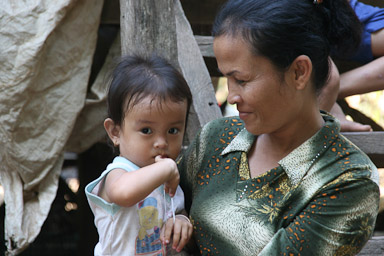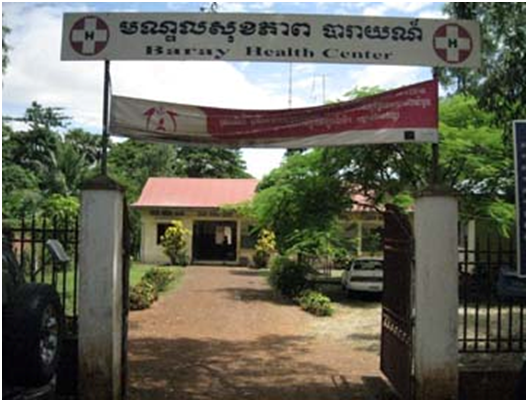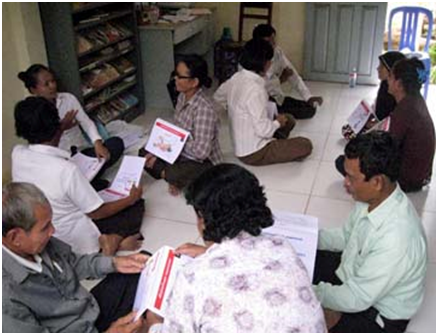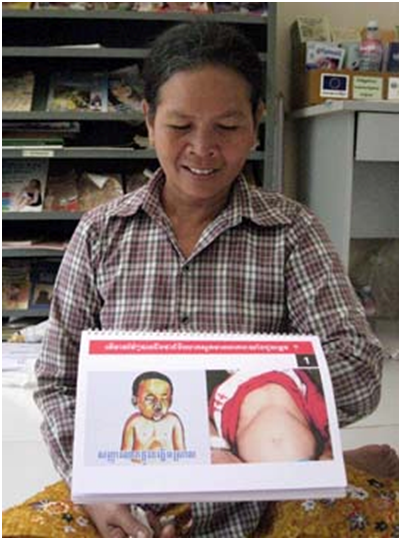It takes a village… and its volunteers
|

Rivann and I are on way to Baray Health Center in Kampong Thom province to observe and speak with health center staff and Village Health Support Group (VHSG) members. We'll learn from them the effects of childhood pneumonia and diarrheal disease in their villages and how integrated training on the two biggest killers of children is crucial in improving the health of their communities. VHSG are volunteer village health workers in Cambodia who educate community members on pertinent health issues and also refer patients to seek proper care at health centers or hospitals. This training is especially important, as every year in Cambodia, about 9,100 children under the age of five die from pneumonia and 2,300 die from diarrhea.
 Driving in the direction of the health center, our car turns down a dusty road lined with open-air family-run eateries and pharmacies. Looking out the window, Rivann exclaims, “Wow! Look at all those people outside of the pharmacy!” I look to where she is pointing, and we drive by a pharmacy where there are several families sitting either on the dirt floor or on plastic chairs under the hot sun waiting for a consultation with a pharmacist to receive treatment for their illness. In Cambodia, many people first seek care from pharmacies and drug sellers before going to the health centers, and by the time they seek proper care, it is often too late. Many people, especially children, die from illnesses including pneumonia and diarrhea because they did not go to the health center soon enough.
Driving in the direction of the health center, our car turns down a dusty road lined with open-air family-run eateries and pharmacies. Looking out the window, Rivann exclaims, “Wow! Look at all those people outside of the pharmacy!” I look to where she is pointing, and we drive by a pharmacy where there are several families sitting either on the dirt floor or on plastic chairs under the hot sun waiting for a consultation with a pharmacist to receive treatment for their illness. In Cambodia, many people first seek care from pharmacies and drug sellers before going to the health centers, and by the time they seek proper care, it is often too late. Many people, especially children, die from illnesses including pneumonia and diarrhea because they did not go to the health center soon enough.
We finally arrive at Baray Health Center, where one of the PATH-supported VHSG trainings is  underway. Rivann and I enter the Youth Resource Room, a sunny, medium-sized room covered with white tiles and health education posters on nutrition, reproductive health, and first aid. Several shelves line the room with magazines and books, and a couple of VHSG browse the materials during the lunch break.
underway. Rivann and I enter the Youth Resource Room, a sunny, medium-sized room covered with white tiles and health education posters on nutrition, reproductive health, and first aid. Several shelves line the room with magazines and books, and a couple of VHSG browse the materials during the lunch break.
It is here that we meet with Chea Yeksim, Vice Chief of Duan Tom village in Baray operational district. Sitting on the cool, white titles, I ask Ms. Yeksim questions in English and as Rivann translates into Khmer, it is obvious from Ms. Yeksim's animated responses how important this training is to the work of the VHSG.
“During the four years that I have been Vice Chief of my village, pneumonia and diarrhea among children are the biggest health issues. Many children in the community, especially the children under the age of five make up a lot of the cases,” Ms. Yeksim tells us.
“Why do you think that is?” I ask.
“Many parents do not have the knowledge about the two illnesses, and they prefer to go to a private pharmacy where they get medicine right away and while yes, it does stop the illness for a short time, many of the children continue to get pneumonia and diarrhea again and again. The pharmacists and the parents don't know how to prevent the child from getting sick again and they certainly don't know the symptoms of when a child has a cold versus when the child has pneumonia.”
I nod vigorously and quickly scribble down Rivann's earlier observations about the crowded pharmacy down the street in the margins of my notebook.
Ms. Yeksim continues, “Many families spend a lot of money on medicines that do not prevent and properly treat their children. If parents knew the signs of these illnesses and when to bring them to the health centers to get proper care, many children would not have to die. Good health also means families have to spend less money on medicines that don't work, and helps reduce their poverty.”
Ms. Yeksim tells us about a young boy who lives across the street from her home, whom she  believes has pneumonia. “The boy's chest is as large as this picture,” pointing to a photo in the training manual. “I will bring back what I've learned from this training, so that good nutrition, proper hygiene and sanitation, and what symptoms to look for if a child has pneumonia and diarrhea will be taught to my village. These simple steps can prevent both illnesses. If families knew what the symptoms were and brought their children to the health center right away, many children would not need to get so sick.”
believes has pneumonia. “The boy's chest is as large as this picture,” pointing to a photo in the training manual. “I will bring back what I've learned from this training, so that good nutrition, proper hygiene and sanitation, and what symptoms to look for if a child has pneumonia and diarrhea will be taught to my village. These simple steps can prevent both illnesses. If families knew what the symptoms were and brought their children to the health center right away, many children would not need to get so sick.”
In September we will go out with the VHSG members to observe them training the mothers of their villages about childhood pneumonia and diarrhea. We will meet and speak with the families whose lives have been affected by these illnesses and learn how simple, proven interventions are instrumental in saving their children's lives.
-- Gizelle V. Gopez is the Program Associate for PATH's Cambodia Country Program and enjoys collecting, sharing, and learning from the experiences and stories of the people she meets in the country.
This blog is part of a series. To read more, visit:
-- In Cambodia, Rising Flood Waters Bring Rise in Diarrheal Disease
-- Cambodia: From Policy to Practice
For more information:
Photo credits, top to bottom:
Heng Chivoan
PATH














